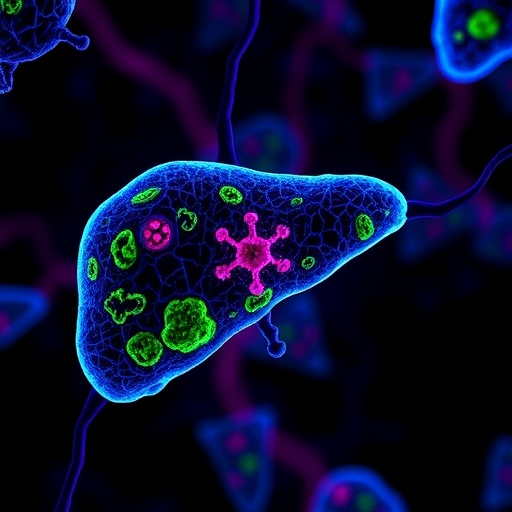A groundbreaking study has unveiled a novel mechanism by which inhibiting ATP citrate lyase (ACLY) triggers a potent antitumour immune response, substantially suppressing liver cancer progression. Researchers investigated genetically modified mouse models lacking ACLY in hepatocytes, alongside pharmacological inhibition, uncovering a surprising connection between lipid metabolism and tumour immunogenicity that redefines therapeutic approaches to hepatocellular carcinoma (HCC).
Delving into the molecular choreography underpinning tumour growth, the researchers performed an extensive bulk RNA sequencing analysis of liver tumours extracted from wild-type (WT) and Acly-knockout (Acly-KO) mice across two critical timepoints. Remarkably, even before any measurable reduction in tumour burden was detected, transcriptional changes indicative of immune activation emerged. This early shift implies that ACLY influences the tumour microenvironment more profoundly than previously appreciated, potentially through direct modulation of immune cell infiltration and activation.
The transcriptomic data revealed a consistent downregulation of Acly expression in knockout mice tumours at both early and late stages, with concomitant metabolic reprogramming evidenced by elevated citrate and decreased succinate levels. Such metabolic shifts were accompanied by suppressed expression of pivotal enzymes like succinate-CoA ligase subunits Suclg1 and Sucla2, marking a metabolic phenotype unfavorable for tumour growth. Intriguingly, upregulation of Acss2 was absent, differentiating this hepatic model from other tissue contexts and underscoring tissue-specific metabolic nuances.
A pivotal discovery of this study was the pronounced increase in genes related to leukocyte proliferation, migration, and activation within ACLY-deficient tumours. Gene Ontology clustering of upregulated genes manifested enrichment in immune-related pathways—T cell and B cell activation, interferon alpha and gamma responses, and leukocyte adhesion—signaling an inflamed tumour microenvironment. As tumour volumes remained unchanged at the early timepoint, these immune activations likely precede and contribute causally to tumour suppression.
Expanding upon this, correlation analyses revealed a robust negative association between ACLY expression and tumour-infiltrating B cells across samples. This inverse relationship suggests that ACLY activity may inhibit B cell-mediated antitumour immunity. The implications of this finding are profound, as plasma cells derived from B cells are known to secrete antibodies and orchestrate immune responses, potentially marking ACLY as a metabolic checkpoint that modulates immune surveillance in liver cancer.
To spatially contextualize these transcriptional insights, the team applied cutting-edge spatial transcriptomics to interrogate the tumour microenvironment in both genetic and pharmacologically treated mouse cohorts. This high-resolution technique uncovered a selective surge in B cell populations within tumours lacking ACLY or treated with EVT0185, a novel pharmacological ACLY inhibitor. Notably, other immune populations such as T cells, macrophages, and natural killer T cells did not show similar increases, highlighting a specific enhancement of B cell responses.
Diving deeper into the identity of these B cells, transcriptomic markers revealed a dominance of plasma cells, indicating a skewing towards antibody-producing effector populations. These plasma cells exhibited enriched fatty acid metabolism pathways, an essential feature for their differentiation and function, suggesting that ACLY inhibition may foster a metabolic milieu conducive to plasma cell development and activity within tumours.
An additional highlight in the tumour immune landscape was the elevated expression of Cxcl13, a critical chemokine involved in recruiting B cells to sites of inflammation. The elevation of Cxcl13 in both genetic and pharmacological models implies that ACLY inhibition amplifies chemotactic signals, drawing robust B cell-mediated immune responses into the tumour microenvironment. Given that Cxcl13 levels are typically reduced in human metabolic-associated steatohepatitis-driven HCC, restoring its expression could have meaningful clinical significance.
Supporting these findings, external RNA sequencing datasets from ACLY-deficient DEN-induced tumours cultured in vitro mirrored the increased Cxcl13 expression, reinforcing the reproducibility and biological relevance of these immune alterations. Altogether, the data showcase ACLY as a metabolic gatekeeper that, when inhibited, unleashes a potent B cell-driven antitumour immune response.
From a metabolic standpoint, tumours deficient in ACLY displayed heightened fatty acid and lipid metabolism signatures, consistent with the altered acetyl-CoA flux caused by ACLY disruption. These metabolic rearrangements within hepatocellular carcinoma cells likely support immune activation and plasma cell differentiation, presenting a unique interplay between tumour metabolism and immune modulation.
The therapeutic relevance of these insights is underscored by the efficacy of EVT0185, the ACLY inhibitor, which recapitulated many of the immune and metabolic effects observed in genetic models. Treatment with EVT0185 not only curtailed tumour progression but also enhanced plasma cell infiltration and Cxcl13 expression, spotlighting pharmacological ACLY inhibition as a promising strategy for augmenting tumour immunity in liver cancer.
Together, these findings establish an unanticipated link between the metabolic enzyme ATP citrate lyase and tumour immunogenicity, particularly highlighting its role in suppressing B cell-mediated antitumour immunity. By dismantling this metabolic barrier, ACLY inhibition fosters a tumour microenvironment enriched with antibody-secreting plasma cells and elevated chemokine signaling, culminating in effective tumour suppression.
This study carves a new path in cancer biology by integrating metabolism, immune surveillance, and tumour progression, offering fresh therapeutic avenues for tackling MASH-driven hepatocellular carcinoma. As metabolic regulators like ACLY become recognized as immune modulators, precision oncology stands to benefit from tailored strategies that harness metabolic vulnerabilities to reinvigorate antitumour immunity.
The implications extend beyond liver cancer, raising the possibility that metabolic reprogramming can broadly influence immune landscapes within tumours. Future research will be critical to explore combinatorial therapies that integrate ACLY inhibition with established immunotherapeutic modalities, potentially amplifying clinical efficacy in a range of malignancies.
In summary, inhibiting ACLY disrupts tumour metabolic homeostasis and unlocks B cell-driven immune responses, leading to suppressed tumour growth in liver cancer models. This dual metabolic-immune mechanism heralds a paradigm shift in understanding and treating tumours, positioning ACLY as a vital target for interventions aiming to boost antitumour immunity and improve patient outcomes.
Subject of Research: ACLY inhibition and its effect on tumour immunity and liver cancer progression
Article Title: ACLY inhibition promotes tumour immunity and suppresses liver cancer
Article References:
Gautam, J., Wu, J., Lally, J.S.V. et al. ACLY inhibition promotes tumour immunity and suppresses liver cancer. Nature (2025). https://doi.org/10.1038/s41586-025-09297-0
Image Credits: AI Generated




